Culture of Canada
The culture of Canada embodies the artistic, culinary, literary, humour, musical, political and social elements that are representative of Canada and Canadians. Throughout Canada's history, its culture has been influenced by European culture and traditions, especially British and French, and by its own indigenous cultures.[1] Over time, elements of the cultures of Canada's immigrant populations have become incorporated to form a Canadian cultural mosaic.[1][2] The population has also been influenced by American culture because of a shared language, proximity, television and migration between the two countries.[3][4]
| Part of a series on the |
| Culture of Canada |
|---|
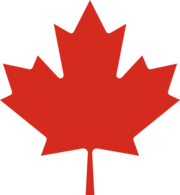 |
| History |
|
| Topics |
|
| Research |
|
|
Canada is often characterized as being "very progressive, diverse, and multicultural".[5] Canada's federal government has often been described as the instigator of multicultural ideology because of its public emphasis on the social importance of immigration.[6] Canada's culture draws from its broad range of constituent nationalities, and policies that promote a just society are constitutionally protected.[7] Canadian Government policies—such as publicly funded health care; higher and more progressive taxation; outlawing capital punishment; strong efforts to eliminate poverty; an emphasis on cultural diversity; strict gun control; the legalization of same-sex marriage, pregnancy terminations, euthanasia and cannabis — are social indicators of the country's political and cultural values.[8][9][10] Canadians identify with the country's institutions of health care, military peacekeeping, the national park system and the Canadian Charter of Rights and Freedoms.[11][12]
The Canadian government has influenced culture with programs, laws and institutions. It has created crown corporations to promote Canadian culture through media, such as the Canadian Broadcasting Corporation (CBC) and the National Film Board of Canada (NFB), and promotes many events which it considers to promote Canadian traditions. It has also tried to protect Canadian culture by setting legal minimums on Canadian content in many media using bodies like the Canadian Radio-television and Telecommunications Commission (CRTC).[13]
Cultural components
Influences
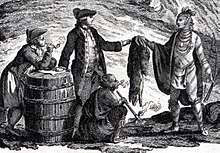
For thousands of years Canada has been inhabited by indigenous peoples from a variety of different cultures and of several major linguistic groupings.[14] Although not without conflict and bloodshed, early European interactions with First Nations and Inuit populations in what is now Canada were arguably peaceful.[15] First Nations and Métis peoples played a critical part in the development of European colonies in Canada, particularly for their role in assisting European coureur des bois and voyageurs in the exploration of the continent during the North American fur trade.[16] Combined with late economic development in many regions, this comparably nonbelligerent early history allowed indigenous Canadians to have a lasting influence on the national culture (see: The Canadian Crown and Aboriginal peoples).[17] Over the course of three centuries, countless North American Indigenous words, inventions, concepts, and games have become an everyday part of Canadian language and use.[18] Many places in Canada, both natural features and human habitations, use indigenous names. The name "Canada" itself derives from the St. Lawrence Iroquoian word meaning "village" or "settlement".[19] The name of Canada's capital city Ottawa comes from the Algonquin language term "adawe" meaning "to trade".[19]
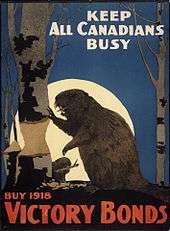
The French originally settled New France along the shores of the Atlantic Ocean and Saint Lawrence River during the early part of the 17th century.[20] The British conquest of New France during the mid-18th century brought 70,000 Francophones under British rule, creating a need for compromise and accommodation.[21] The migration of 40,000 to 50,000 United Empire Loyalists from the Thirteen Colonies during the American Revolution (1775–1783) brought American colonial influences.[21] Following the War of 1812, a large wave of Irish, Scottish and English settlers arrived in Upper Canada and Lower Canada.[21]
The Canadian Forces and overall civilian participation in the First World War and Second World War helped to foster Canadian nationalism;[22] however, in 1917 and 1944, conscription crises highlighted the considerable rift along ethnic lines between Anglophones and Francophones.[23] As a result of the First and Second World Wars, the Government of Canada became more assertive and less deferential to British authority.[24] Canada until the 1940s saw itself in terms of English and French cultural, linguistic and political identities, and to some extent aboriginal.[25]
Legislative restrictions on immigration (such as the Continuous journey regulation and Chinese Immigration Act) that had favoured British, American and other European immigrants (such as Dutch, German, Italian, Polish, Swedish and Ukrainian) were amended during the 1960s,[26][27] resulting in an influx of diverse people from Asia, Africa, and the Caribbean.[28] By the end of the 20th century, immigrants were increasingly Chinese, Indian, Vietnamese, Jamaican, Filipino, Lebanese and Haitian.[29] As of 2006, Canada has grown to have thirty four ethnic groups with at least one hundred thousand members each, of which eleven have over 1,000,000 people and numerous others are represented in smaller numbers.[30] 16.2% of the population self identify as a visible minority.[30] The Canadian public as-well as the major political parties support immigration.[31]
Development of popular culture
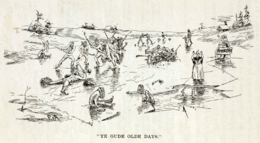
Themes and symbols of pioneers, trappers, and traders played an important part in the early development of Canadian culture.[32] Modern Canadian culture as it is understood today can be traced to its time period of westward expansion and nation building.[33] Contributing factors include Canada's unique geography, climate, and cultural makeup. Being a cold country with long winter nights for most of the year, certain unique leisure activities developed in Canada during this period including hockey and embracement of the summer indigenous game of lacrosse.[34][35][36]
By the 19th century Canadians came to believe themselves possessed of a unique "northern character," due to the long, harsh winters that only those of hardy body and mind could survive.[37] This hardiness was claimed as a Canadian trait, and such sports as snowshoeing and cross-country skiing that reflected this were asserted as characteristically Canadian.[38] During this period the churches tried to steer leisure activities, by preaching against drinking and scheduling annual revivals and weekly club activities.[39] In a society in which most middle-class families now owned a harmonium or piano, and standard education included at least the rudiments of music, the result was often an original song.[40] Such stirrings frequently occurred in response to noteworthy events, and few local or national excitements were allowed to pass without some musical comment.[41][42]
By the 1930s radio played a major role in uniting Canadians behind their local or regional teams. Rural areas were especially influenced by sports coverage and the propagation of national myths.[43] Outside the sports and music arena Canadians express the national characteristics of being hard working, peaceful, orderly and polite.[44]
Political culture
Historical cultural legislation
French Canada's early development was relatively cohesive during the 17th and 18th centuries, and this was preserved by the Quebec Act of 1774, which allowed Roman Catholics to hold offices and practice their faith.[45] In 1867, the Constitution Act was thought to meet the growing calls for Canadian autonomy while avoiding the overly strong decentralization that contributed to the Civil War in the United States.[46] The compromises reached during this time between the English- and French-speaking Fathers of Confederation set Canada on a path to bilingualism which in turn contributed to an acceptance of diversity.[47] The English and French languages have had limited constitutional protection since 1867 and full official status since 1969.[48] Section 133 of the Constitution Act of 1867 (BNA Act) guarantees that both languages may be used in the Parliament of Canada.[48] Canada adopted its first Official Languages Act in 1969, giving English and French equal status in the government of Canada.[49] Doing so makes them "official" languages, having preferred status in law over all other languages used in Canada.[49]
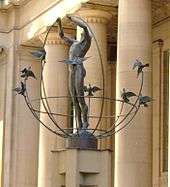
Prior to the advent of the Canadian Bill of Rights in 1960 and its successor the Canadian Charter of Rights and Freedoms in 1982, the laws of Canada did not provide much in the way of civil rights and this issue was typically of limited concern to the courts.[50] Canada since the 1960s has placed emphasis on equality and inclusiveness for all people.[51] Multiculturalism in Canada was adopted as the official policy of the Canadian government and is enshrined in Section 27 of the Canadian Charter of Rights and Freedoms.[52][53] In 1995, the Supreme Court of Canada ruled in Egan v. Canada that sexual orientation should be "read in" to Section Fifteen of the Canadian Charter of Rights and Freedoms, a part of the Constitution of Canada guaranteeing equal rights to all Canadians.[54] Following a series of decisions by provincial courts and the Supreme Court of Canada, on July 20, 2005, the Civil Marriage Act (Bill C-38) received Royal Assent, legalizing same-sex marriage in Canada.[55] Furthermore, sexual orientation was included as a protected status in the human-rights laws of the federal government and of all provinces and territories.[56]
Contemporary politics
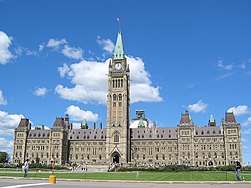
Canadian governments at the federal level have a tradition of liberalism,[57] and govern with a moderate, centrist political ideology.[58][59] Canada's egalitarian approach to governance emphasizing social justice and multiculturalism, is based on selective immigration, social integration, and suppression of far-right politics that has wide public and political support.[60][61] Peace, order, and good government are constitutional goals of the Canadian government.[62]
Canada has a multi-party system in which many of its legislative customs derive from the unwritten conventions of and precedents set by the Westminster parliament of the United Kingdom. The country has been dominated by two parties,[63] the centre-left Liberal Party of Canada and the centre-right Conservative Party of Canada.[64] The historically predominant Liberals position themselves at the centre of the political scale,[65] with the Conservatives sitting on the right and the New Democratic Party occupying the left.[63] Smaller parties like the Quebec nationalist Bloc Québécois and the Green Party of Canada have also been able to exert their influence over the political process by representation at the federal level.
Nationalism and protectionism
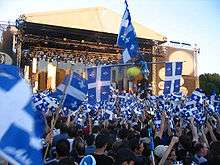
In general, Canadian nationalists are highly concerned about the protection of Canadian sovereignty and loyalty to the Canadian State, placing them in the civic nationalist category. It has likewise often been suggested that anti-Americanism plays a prominent role in Canadian nationalist ideologies.[66] A unified, bi-cultural, tolerant and sovereign Canada remains an ideological inspiration to many Canadian nationalists.[67] Alternatively French Canadian nationalism and support for maintaining French Canadian culture would inspire Quebec nationalists, many of whom were supporters of the Quebec sovereignty movement during the late-20th century.[68]
Cultural protectionism in Canada has, since the mid-20th century, taken the form of conscious, interventionist attempts on the part of various Canadian governments to promote Canadian cultural production.[69] Sharing a large border and (for the majority) a common language with the United States, Canada faces a difficult position in regard to American culture, be it direct attempts at the Canadian market or the general diffusion of American culture in the globalized media arena. While Canada tries to maintain its cultural differences, it also must balance this with responsibility in trade arrangements such as the General Agreement on Tariffs and Trade (GATT) and the North American Free Trade Agreement (NAFTA).[70]
Values
Canadian values are the perceived commonly shared ethical and human values of Canadians. The major political parties have claimed explicitly that they uphold Canadian values, but use generalities to specify them. Historian Ian MacKay argues that, thanks to the long-term political impact of "Rebels, Reds, and Radicals", and allied leftist political elements, "egalitarianism, social equality, and peace... are now often simply referred to...as 'Canadian values.'"[71]
A 2013 Statistics Canada survey found that an "overwhelming majority" of Canadians shared the values of human rights (with 92% of respondents agreeing that they are a shared Canadian value), respect for the law (92%) and gender equality (91%).[72] Universal access to publicly funded health services "is often considered by Canadians as a fundamental value that ensures national health care insurance for everyone wherever they live in the country." [73]
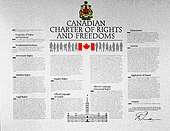
The Canadian Charter of Rights and Freedoms, was intended to be a source for Canadian values and national unity.[74] The 15th Prime Minister Pierre Trudeau wrote in his Memoirs that:
Canada itself could now be defined as a "society where all people are equal and where they share some fundamental values based upon freedom", and that all Canadians could identify with the values of liberty and equality.[75]
Numerous scholar, beginning in the 1940s with American sociologist Seymour Martin Lipset; have tried to identify, measure and compare them with other countries, especially the United States.[76][77] However, there are critics who say that such a task is practically impossible.[78]
Denis Stairs a professor of political Science at Dalhousie University; links the concept of Canadian values with nationalism. [Canadians typically]...believe, in particular, that they subscribe to a distinctive set of values - Canadian values - and that those values are special in the sense of being unusually virtuous.[79]
Identity

Canada's large geographic size, the presence of a significant number of indigenous peoples, the conquest of one European linguistic population by another and relatively open immigration policy have led to an extremely diverse society. As a result, the issue of Canadian identity remains under scrutiny.[80]
Canada has constitutional protection for policies that promote multiculturalism rather than cultural assimilation or a single national myth.[81] In Quebec, cultural identity is strong, and many commentators speak of a French Canadian culture as distinguished from English Canadian culture.[82] However, as a whole, Canada is in theory, a cultural mosaic—a collection of several regional, and ethnic subcultures.[83][84] Political philosopher Charles Blattberg suggests that Canada is a "multinational country"; as all Canadians are members of Canada as a civic or political community, a community of citizens, and this is a community that contains many other kinds within it. These include not only communities of ethnic, regional, religious, and civic (the provincial and municipal governments) sorts, but also national communities, which often include or overlap with many of the other kinds.[85]
Journalist and author Richard Gwyn has suggested that "tolerance" has replaced "loyalty" as the touchstone of Canadian identity.[86] Journalist and professor Andrew Cohen wrote in 2007:
The Canadian Identity, as it has come to be known, is as elusive as the Sasquatch and Ogopogo. It has animated—and frustrated—generations of statesmen, historians, writers, artists, philosophers, and the National Film Board ... Canada resists easy definition.[87]
Canada's 15th prime minister Pierre Trudeau in regards to uniformity stated:
Uniformity is neither desirable nor possible in a country the size of Canada. We should not even be able to agree upon the kind of Canadian to choose as a model, let alone persuade most people to emulate it. There are few policies potentially more disastrous for Canada than to tell all Canadians that they must be alike. There is no such thing as a model or ideal Canadian. What could be more absurd than the concept of an “all-Canadian” boy or girl? A society which emphasizes uniformity is one which creates intolerance and hate.[88]
The question of Canadian identity was traditionally dominated by three fundamental themes: first, the often conflicted relations between English Canadians and French Canadians stemming from the French Canadian imperative for cultural and linguistic survival; secondly, the generally close ties between English Canadians and the British Empire, resulting in a gradual political process towards complete independence from the imperial power; and finally, the close proximity of English-speaking Canadians to the United States.[89] Much of the debate over contemporary Canadian identity is argued in political terms, and defines Canada as a country defined by its government policies, which are thought to reflect deeper cultural values.[90]
In 2013, more than 90% of Canadians believed that the Canadian Charter of Rights and Freedoms and the national flag were the top symbols of Canadian identity. Next highest were the national anthem, the Royal Canadian Mounted Police and hockey.[91]
Inter-provincial interactions
Western alienation is the notion that the western provinces have historically been alienated, and in extreme cases excluded, from mainstream Canadian political affairs in favour of Eastern Canada or more specifically the central provinces.[92] Western alienation claims that these latter two are politically represented, and economically favoured, more significantly than the former, which has given rise to the sentiment of alienation among many western Canadians.[93] Likewise; the Quebec sovereignty movement of the late 20th century that lead to the Québécois nation being recognized as a "distinct society" within Canada, highlights the sharp divisions between the Anglo and Francophone population.[94]
Though more than half of Canadians live in just two provinces: Ontario and Quebec, each province is largely self-contained due to provincial economic self-sufficiency. Only 15 percent of Canadians live in a different province from where they were born, and only 10 percent go to another province for university. Canada has always been like that, and stands in sharp contrast to the United States' internal mobility which is much higher. For example 30 percent live in a different state from where they were born, and 30 percent go away for university. Scott Gilmore in Maclean's argues that "Canada is a nation of strangers", in the sense that for most individuals, the rest of Canada outside their province is little-known. Another factor is the cost of internal travel. Intra-Canadian airfares are high—it is cheaper and more common to visit the United States than to visit another province. Gilmore argues that the mutual isolation makes it difficult to muster national responses to major national issues.[95]
Humour
Canadian humour is an integral part of the Canadian Identity. There are several traditions in Canadian humour in both English and French.[96][97] While these traditions are distinct and at times very different, there are common themes that relate to Canadians' shared history and geopolitical situation in the Western Hemisphere and the world. Various trends can be noted in Canadian comedy. One trend is the portrayal of a "typical" Canadian family in an ongoing radio or television series.[98] Other trends include outright absurdity,[99] and political and cultural satire.[100] Irony, parody, satire, and self-deprecation are arguably the primary characteristics of Canadian humour.[101][102][103]
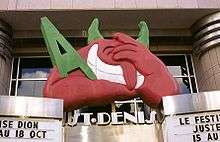
The beginnings of Canadian national radio comedy date to the late 1930s with the debut of The Happy Gang, a long-running weekly variety show that was regularly sprinkled with corny jokes in between tunes.[104] Canadian television comedy begins with Wayne and Shuster, a sketch comedy duo who performed as a comedy team during the Second World War, and moved their act to radio in 1946 before moving on to television.[105] Second City Television, otherwise known as SCTV, Royal Canadian Air Farce, This Hour Has 22 Minutes, The Kids in the Hall and more recently Trailer Park Boys are regarded as television shows which were very influential on the development of Canadian humour.[106] Canadian comedians have had great success in the film industry and are amongst the most recognized in the world.[106]
Humber College in Toronto and the École nationale de l'humour in Montreal offer post-secondary programmes in comedy writing and performance.[107] Montreal is also home to the bilingual (English and French) Just for Laughs festival and to the Just for Laughs Museum, a bilingual, international museum of comedy.[108] Canada has a national television channel, The Comedy Network, devoted to comedy. Many Canadian cities feature comedy clubs and showcases, most notable, The Second City branch in Toronto (originally housed at The Old Fire Hall) and the Yuk Yuk's national chain.[109] The Canadian Comedy Awards were founded in 1999 by the Canadian Comedy Foundation for Excellence, a not-for-profit organization.[110]
Symbols
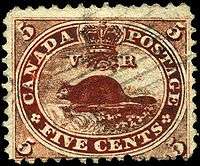
Predominant symbols of Canada include the maple leaf, beaver, and the Canadian horse.[111][112][113] Many official symbols of the country such as the Flag of Canada have been changed or modified over the past few decades to Canadianize them and de-emphasise or remove references to the United Kingdom.[114] Other prominent symbols include the sports of hockey and lacrosse, the Canadian Goose, the Royal Canadian Mounted Police, the Canadian Rockies,[115] and more recently the totem pole and Inuksuk.[116] With material items such as Canadian beer, maple syrup, tuques, canoes, nanaimo bars, butter tarts and the Quebec dish of poutine being defined as uniquely Canadian.[116][117] Symbols of the Canadian monarchy continue to be featured in, for example, the Arms of Canada, the armed forces, and the prefix Her Majesty's Canadian Ship. The designation Royal remains for institutions as varied as the Royal Canadian Armed Forces, Royal Canadian Mounted Police and the Royal Winnipeg Ballet.[118][119]
Arts
Visual arts
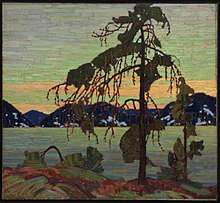
Indigenous artists were producing art in the territory that is now called Canada for thousands of years prior to the arrival of European settler colonists and the eventual establishment of Canada as a nation state.[120] Like the peoples that produced them, indigenous art traditions spanned territories that extended across the current national boundaries between Canada and the United States.[121] The majority of indigenous artworks preserved in museum collections date from the period after European contact and show evidence of the creative adoption and adaptation of European trade goods such as metal and glass beads.[122] Canadian sculpture has been enriched by the walrus ivory, muskox horn and caribou antler and soapstone carvings by the Inuit artists.[123] These carvings show objects and activities from the daily life, myths and legends of the Inuit.[124] Inuit art since the 1950s has been the traditional gift given to foreign dignitaries by the Canadian government.[125]
The works of most early Canadian painters followed European trends.[126] During the mid-19th century, Cornelius Krieghoff, a Dutch-born artist in Quebec, painted scenes of the life of the habitants (French-Canadian farmers). At about the same time, the Canadian artist Paul Kane painted pictures of indigenous life in western Canada. A group of landscape painters called the Group of Seven developed the first distinctly Canadian style of painting.[127] All these artists painted large, brilliantly coloured scenes of the Canadian wilderness.
Since the 1930s, Canadian painters have developed a wide range of highly individual styles. Emily Carr became famous for her paintings of totem poles in British Columbia.[128] Other noted painters have included the landscape artist David Milne, the painters Jean-Paul Riopelle, Harold Town and Charles Carson and multi-media artist Michael Snow. The abstract art group Painters Eleven, particularly the artists William Ronald and Jack Bush, also had an important impact on modern art in Canada.[129] Government support has played a vital role in their development enabling visual exposure through publications and periodicals featuring Canadian art, as has the establishment of numerous art schools and colleges across the country.[130]
Literature

Canadian literature is often divided into French- and English-language literatures, which are rooted in the literary traditions of France and Britain, respectively.[131] Canada's early literature, whether written in English or French, often reflects the Canadian perspective on nature, frontier life, and Canada's position in the world, for example the poetry of Bliss Carman or the memoirs of Susanna Moodie and Catherine Parr Traill. These themes, and Canada's literary history, inform the writing of successive generations of Canadian authors, from Leonard Cohen to Margaret Atwood.
By the mid-20th century, Canadian writers were exploring national themes for Canadian readers. Authors were trying to find a distinctly Canadian voice, rather than merely emulating British or American writers. Canadian identity is closely tied to its literature. The question of national identity recurs as a theme in much of Canada's literature, from Hugh MacLennan's Two Solitudes (1945) to Alistair MacLeod's No Great Mischief (1999). Canadian literature is often categorized by region or province; by the socio-cultural origins of the author (for example, Acadians, indigenous peoples, LGBT, and Irish Canadians); and by literary period, such as "Canadian postmoderns" or "Canadian Poets Between the Wars".
Canadian authors have accumulated numerous international awards.[132] In 1992, Michael Ondaatje became the first Canadian to win the Man Booker Prize for The English Patient.[133] Margaret Atwood won the Booker in 2000 for The Blind Assassin[134] and Yann Martel won it in 2002 for the Life of Pi.[135] Carol Shields's The Stone Diaries won the Governor General's Awards in Canada in 1993, the 1995 Pulitzer Prize for Fiction, and the 1994 National Book Critics Circle Award.[136] In 2013, Alice Munro was the first Canadian to be awarded the Nobel Prize in Literature for her work as "master of the modern short story".[137] Munro is also a recipient of the Man Booker International Prize for her lifetime body of work, and three-time winner of Canada's Governor General's Award for fiction.[138]
Theatre
Canada has had a thriving stage theatre scene since the late 1800s.[139] Theatre festivals draw many tourists in the summer months, especially the Stratford Shakespeare Festival in Stratford, Ontario, and the Shaw Festival in Niagara-on-the-Lake, Ontario. The Famous People Players are only one of many touring companies that have also developed an international reputation.[140] Canada also hosts one of the largest fringe festivals, the Edmonton International Fringe Festival.[141]
Canada's largest cities host a variety of modern and historical venues. The Toronto Theatre District is Canada's largest, as well as being the third largest English-speaking theatre district in the world.[142] In addition to original Canadian works, shows from the West End and Broadway frequently tour in Toronto. Toronto's Theatre District includes the venerable Roy Thomson Hall; the Princess of Wales Theatre; the Tim Sims Playhouse; The Second City; the Canon Theatre; the Panasonic Theatre; the Royal Alexandra Theatre; historic Massey Hall; and the city's new opera house, the Sony Centre for the Performing Arts.[143] Toronto's Theatre District also includes the Theatre Museum Canada.
Montreal's theatre district ("Quartier des Spectacles") is the scene of performances that are mainly French-language, although the city also boasts a lively anglophone theatre scene, such as the Centaur Theatre.[144] Large French theatres in the city include Théâtre Saint-Denis and Théâtre du Nouveau Monde.[145]
Vancouver is host to, among others, the Vancouver Fringe Festival, the Arts Club Theatre Company, Carousel Theatre, Bard on the Beach, Theatre Under the Stars and Studio 58.[146]
Calgary is home to Theatre Calgary, a mainstream regional theatre; Alberta Theatre Projects, a major centre for new play development in Canada; the Calgary Animated Objects Society; and One Yellow Rabbit, a touring company.[147]
There are three major theatre venues in Ottawa; the Ottawa Little Theatre, originally called the Ottawa Drama League at its inception in 1913, is the longest-running community theatre company in Ottawa.[148] Since 1969, Ottawa has been the home of the National Arts Centre, a major performing-arts venue that houses four stages and is home to the National Arts Centre Orchestra, the Ottawa Symphony Orchestra and Opera Lyra Ottawa.[149] Established in 1975, the Great Canadian Theatre Company specializes in the production of Canadian plays at a local level.[150]
Television
Canadian television, especially supported by the Canadian Broadcasting Corporation,[151] is the home of a variety of locally produced shows. French-language television, like French Canadian film, is buffered from excessive American influence by the fact of language, and likewise supports a host of home-grown productions.[152] The success of French-language domestic television in Canada often exceeds that of its English-language counterpart. In recent years nationalism has been used to prompt products on television. The I Am Canadian campaign by Molson beer, most notably the commercial featuring Joe Canadian, infused domestically brewed beer and nationalism.[153][154]
Canada's television industry is in full expansion as a site for Hollywood productions.[155] Since the 1980s, Canada, and Vancouver in particular, has become known as Hollywood North.[156] The American TV series Queer as Folk was filmed in Toronto. Canadian producers have been very successful in the field of science fiction since the mid-1990s, with such shows as The X-Files, Stargate SG-1, Highlander: The Series, the new Battlestar Galactica, My Babysitter's A Vampire, Smallville, and The Outer Limits, all filmed in Vancouver.[157]
The CRTC's Canadian content regulations dictate that a certain percentage of a domestic broadcaster's transmission time must include content that is produced by Canadians, or covers Canadian subjects.[158] These regulations also apply to US cable television channels such as MTV and the Discovery Channel, which have local versions of their channels available on Canadian cable networks. Similarly, BBC Canada, while showing primarily BBC shows from the United Kingdom, also carries Canadian output.
Film
A number of Canadian pioneers in early Hollywood significantly contributed to the creation of the motion picture industry in the early days of the 20th century.[159] Over the years, many Canadians have made enormous contributions to the American entertainment industry, although they are frequently not recognized as Canadians.[160]
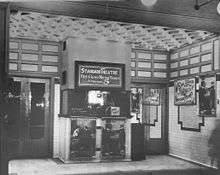
Canada has developed a vigorous film industry that has produced a variety of well-known films, actors and actresses.[161] In fact, this eclipsing may sometimes be creditable for the bizarre and innovative directions of some works,[161] such as auteurs Atom Egoyan (The Sweet Hereafter, 1997) and David Cronenberg (The Fly, Naked Lunch, A History of Violence) and the avant-garde work of Michael Snow and Jack Chambers. Also, the distinct French-Canadian society permits the work of directors such as Denys Arcand and Denis Villeneuve, while First Nations cinema includes the likes of Atanarjuat: The Fast Runner. At the 76th Academy Awards, Arcand's The Barbarian Invasions became Canada's first film to win the Academy Award for Best Foreign Language Film.[162]
The National Film Board of Canada is 'a public agency that produces and distributes films and other audiovisual works which reflect Canada to Canadians and the rest of the world'.[163] Canada has produced many popular documentaries such as The Corporation, Nanook of the North, Final Offer, and Canada: A People's History. The Toronto International Film Festival (TIFF) is considered by many to be one of the most prevalent film festivals for Western cinema. It is the première film festival in North America from which the Oscars race begins.[164]
Music
The music of Canada has reflected the multi-cultural influences that have shaped the country. Indigenous, the French, and the British have all made historical contributions to the musical heritage of Canada. The country has produced its own composers, musicians and ensembles since the mid-1600s.[165][166] From the 17th century onward, Canada has developed a music infrastructure that includes church halls; chamber halls; conservatories; academies; performing arts centres; record companys; radio stations, and television music-video channels.[167][168] The music has subsequently been heavily influenced by American culture because of its proximity and migration between the two countries.[169][170][171] Canadian rock has had a considerable impact on the development of modern popular music and the development of the most popular subgenres.[172]
Patriotic music in Canada dates back over 200 years as a distinct category from British patriotism, preceding the first legal steps to independence by over 50 years. The earliest known song, "The Bold Canadian", was written in 1812.[173] The national anthem of Canada, "O Canada" adopted in 1980,[174] was originally commissioned by the Lieutenant Governor of Quebec, the Honourable Théodore Robitaille, for the 1880 Saint-Jean-Baptiste Day ceremony.[175] Calixa Lavallée wrote the music, which was a setting of a patriotic poem composed by the poet and judge Sir Adolphe-Basile Routhier. The text was originally only in French, before English lyrics were written in 1906.[176]
Music broadcasting in the country is regulated by the Canadian Radio-television and Telecommunications Commission (CRTC). The Canadian Academy of Recording Arts and Sciences presents Canada's music industry awards, the Juno Awards, which were first awarded in a ceremony during the summer of 1970.[177]
Media
Canada has a well-developed media sector, but its cultural output—particularly in English films, television shows, and magazines—is often overshadowed by imports from the United States.[178] Television, magazines, and newspapers are primarily for-profit corporations based on advertising, subscription, and other sales-related revenues. Nevertheless, both the television broadcasting and publications sectors require a number of government interventions to remain profitable, ranging from regulation that bars foreign companies in the broadcasting industry to tax laws that limit foreign competition in magazine advertising.[179]
The promotion of multicultural media in Canada began in the late 1980s as the multicultural policy was legislated in 1988.[180] In the Multiculturalism Act, the federal government proclaimed the recognition of the diversity of Canadian culture.[180] Thus, multicultural media became an integral part of Canadian media overall. Upon numerous government reports showing lack of minority representation or minority misrepresentation, the Canadian government stressed separate provision be made to allow minorities and ethnicities of Canada to have their own voice in the media.[181]
Sports
Sports in Canada consists of a variety of games. Although there are many contests that Canadians value, the most common are ice hockey, box lacrosse, Canadian football, basketball, soccer, curling, baseball and ringette. All but curling and soccer are considered domestic sports as they were either invented by Canadians or trace their roots to Canada.[182]
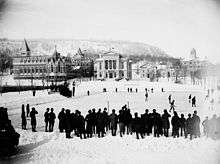
Ice hockey, referred to as simply "hockey", is Canada's most prevalent winter sport, its most popular spectator sport, and its most successful sport in international competition. It is Canada's official national winter sport.[183] Lacrosse, a sport with indigenous origins, is Canada's oldest and official summer sport.[183] Canadian football is Canada's second most popular spectator sport,[184] and the Canadian Football League's annual championship, the Grey Cup, is the country's largest annual sports event.[185]
While other sports have a larger spectator base, association football, known in Canada as soccer in both English and French, has the most registered players of any team sport in Canada, and is the most played sport with all demographics, including ethnic origin, ages and genders.[186] Professional teams exist in many cities in Canada – with a trio of teams in North America's top pro league, Major League Soccer – and international soccer competitions such as the FIFA World Cup, UEFA Euro and the UEFA Champions League attract some of the biggest audiences in Canada.[187] Other popular team sports include curling, street hockey, cricket, rugby league, rugby union, softball and Ultimate frisbee. Popular individual sports include auto racing, boxing, karate, kickboxing, hunting, sport shooting, fishing, cycling, golf, hiking, horse racing, ice skating, skiing, snowboarding, swimming, triathlon, disc golf, water sports, and several forms of wrestling.
As a country with a generally cool climate, Canada has enjoyed greater success at the Winter Olympics than at the Summer Olympics, although significant regional variations in climate allow for a wide variety of both team and individual sports. Great achievements in Canadian sports are recognized by Canada's Sports Hall of Fame,[188] while the Lou Marsh Trophy is awarded annually to Canada's top athlete by a panel of journalists.[189] There are numerous other Sports Halls of Fame in Canada.[188]
Cuisine
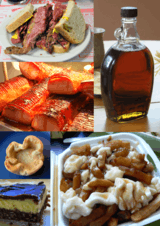
Canadian cuisine varies widely depending on the region. The former Canadian prime minister Joe Clark has been paraphrased to have noted: "Canada has a cuisine of cuisines. Not a stew pot, but a smorgasbord."[190] There are considerable overlaps between Canadian food and the rest of the cuisine in North America, many unique dishes (or versions of certain dishes) are found and available only in the country. Common contenders for the Canadian national food include poutine[191][192][193] and butter tarts.[194][195] Other popular Canadian made foods include indigenous fried bread bannock, French tourtière, Kraft Dinner, ketchup chips, date squares, nanaimo bars, back bacon, and the caesar cocktail.[196] Canada is the birthplace and world's largest producer of maple syrup.[197]
The three earliest cuisines of Canada have First Nations, English, and French roots, with the traditional cuisine of English Canada closely related to British and American cuisine, while the traditional cuisine of French Canada has evolved from French cuisine and the winter provisions of fur traders.[198] With subsequent waves of immigration in the 18th and 19th century from Central, Southern, and Eastern Europe, and then from Asia, Africa and Caribbean, the regional cuisines were subsequently augmented.[198] The Jewish immigrants to Canada during the late 1800s also play a significant role to foods in Canada. The Montreal-style bagel and Montreal-style smoked meat are both food items originally developed by Jewish communities living in Montreal.[199]
Outside views
In a 2002 interview with the Globe and Mail, Aga Khan, the 49th Imam of the Ismaili Muslims, described Canada as "the most successful pluralist society on the face of our globe",[200] citing it as "a model for the world".[201] A 2007 poll ranked Canada as the country with the most positive influence in the world. 28,000 people in 27 countries were asked to rate 12 countries as either having a positive or negative worldwide influence. Canada's overall influence rating topped the list with 54 per cent of respondents rating it mostly positive and only 14 per cent mostly negative.[202] A global opinion poll for the BBC saw Canada ranked the second most positively viewed nation in the world (behind Germany) in 2013 and 2014.[203][204]
The United States is home to a number of perceptions about Canadian culture, due to the countries' partially shared heritage and the relatively large number of cultural features common to both the US and Canada.[205] For example, the average Canadian may be perceived as more reserved than his or her American counterpart.[206] Canada and the United States are often inevitably compared as sibling countries, and the perceptions that arise from this oft-held contrast have gone to shape the advertised worldwide identities of both nations: the United States is seen as the rebellious child of the British Crown, forged in the fires of violent revolution; Canada is the calmer offspring of the United Kingdom, known for a more relaxed national demeanour.[207][208]
See also
- Canadiana
- Canadian folklore
- Culture of Alberta
- Culture of Manitoba
- Culture of Saskatchewan
- Culture of Quebec
- History of free speech in Canada
- Public holidays in Canada
- Canadian French
- List of Canadians

References
- Sana Loue; Martha Sajatovic (2011). Encyclopedia of Immigrant Health. Springer. p. 337. ISBN 978-1-4419-5655-2.
- Paul R. Magocsi; Multicultural History Society of Ontario (1999). Encyclopedia of Canada's Peoples. University of Toronto Press. pp. 1186–1187. ISBN 978-0-8020-2938-6.
- Organisation for Economic Co-operation and Development (1999). Economic and cultural transition towards a learning city: the case of Jena. OECD Publishing. p. 48. ISBN 978-92-64-17015-5.
- Christopher Ricks; Leonard Michaels (1990). The State of the language. University of California Press. p. 19. ISBN 978-0-520-05906-1.
- Anne-Marie Mooney Cotter (2011). Culture clash: an international legal perspective on ethnic discrimination. Ashgate Publishing, Ltd. p. 176. ISBN 978-1-4094-1936-5.
- Azeezat Johnson; Remi Joseph-Salisbury; Beth Kamunge (2018). The Fire Now: Anti-Racist Scholarship in Times of Explicit Racial Violence. Zed Books. p. 148. ISBN 978-1-78699-382-3.
- Sheila Petty; Garry Sherbert; Annie Gérin (2006). Canadian Cultural Poesis: Essays on Canadian Culture. Wilfrid Laurier Univ. Press. p. 348. ISBN 978-0-88920-486-7.
- James Hollifield; Philip L. Martin; Pia Orrenius (2014). Controlling Immigration: A Global Perspective, Third Edition. Stanford University Press. p. 103. ISBN 978-0-8047-8735-2.
- Darrell Bricker; John Wright; Ipsos-Reid (Firm) (2005). What Canadians think- about almost- everything. Doubleday Canada. pp. 8–20. ISBN 978-0-385-65985-7.
- "Examples of Charter-related cases - Canada's System of Justice". Department of Justice - Government of Canada. 2018.
- The Environics Institute (2010). "Focus Canada (Final Report)" (PDF). Queen's University. p. 4 (PDF page 8). Archived from the original (PDF) on February 4, 2016. Retrieved December 12, 2015.
- Nanos Research (October 2016). "Exploring Canadian values" (PDF). Archived from the original (PDF) on April 5, 2017. Retrieved February 1, 2017.
- National Film Board of Canada (2005). "Mandate of the National Film Board". Archived from the original on April 21, 2006. Retrieved March 15, 2006.
- Trevor W. Harrison, John W. Friesen; Trevor Harrison; John W. Friesen (2010). Canadian Society in the Tw.enty-first Century: An Historical Sociological Approach. Canadian Scholars’ Press. p. 186. ISBN 978-1-55130-371-0.
- David L. Preston (2009). The Texture of Contact: European and Indian Settler Communities on the Frontiers of Iroquoia, 1667–1783. U of Nebraska Press. pp. 43–44. ISBN 978-0-8032-2549-7.
- J.R. Miller (2009). Compact, Contract, Covenant: Aboriginal Treaty-Making in Canada. University of Toronto Press. p. 34. ISBN 978-1-4426-9227-5.
- Patrick Macklem (2001). Indigenous difference and the Constitution of Canada. University of Toronto Press. p. 136. ISBN 978-0-8020-8049-3.
- Newhouse, David. "Hidden in Plain Sight Aboriginal Contributions to Canada and Canadian Identity Creating a new Indian Problem" (PDF). Centre of Canadian Studies, University of Edinburgh. Archived from the original (PDF) on July 23, 2011. Retrieved October 17, 2009.
- "Aboriginal place names contribute to a rich tapestry". Indian and Northern Affairs Canada. Archived from the original on February 10, 2010. Retrieved October 17, 2009.
- John C. Hudson (2002). Across this land: a regional geography of the United States and Canada. JHU Press. p. 15. ISBN 978-0-8018-6567-1.
- John Powell (2009). Encyclopedia of North American Immigration. Infobase Publishing. p. 45. ISBN 978-1-4381-1012-7.
- R. Douglas Francis, ed. (November 1, 2011). Canada and the British World: Culture, Migration, and Identity. UBC Press. p. 2. ISBN 978-0-7748-4031-6.
- Christopher Edward Taucar (2002). Canadian Federalism and Quebec Sovereignty. 47. American university studies: Political science. pp. 47–48. ISBN 978-0-8204-6242-4.
- Wayne C. Thompson (2013). Canada World Today. Rowman & Littlefield. p. 61. ISBN 978-1-4758-0474-4.
- Guy M. Robinson (1991). A Social geography of Canada. Dundurn Press Ltd. p. 86. ISBN 978-1-55002-092-2.
- Peter Kivisto (2008). Multiculturalism in a Global Society. John Wiley & Sons. p. 90. ISBN 978-0-470-69480-0.
- Patricia E.. Bromley (2011). Human Rights, Diversity, and National Identity: Changes in Civic Education Textbooks Cross-nationally (1970–2008) and in British Columbia (1871–2008). Stanford University. pp. 107–108. STANFORD:XT006FZ3167.
- Edward Ksenych; David Liu (2001). Conflict, order and action: readings in sociology. Canadian Scholars' Press. p. 407. ISBN 978-1-55130-192-1.
- "Immigration Policy in the 1970s". Canadian Heritage (Multicultural Canada). 2004. Archived from the original on November 5, 2009. Retrieved April 12, 2010.
- "2006 Census release topics". Statistics Canada. Retrieved January 16, 2011.
- James Hollifield; Philip Martin; Pia Orrenius (2014). Controlling Immigration: A Global Perspective, Third Edition. Stanford University Press. p. 11. ISBN 978-0-8047-8627-0.
- "Canada in the Making: Pioneers and Immigrants". The History Channel. August 25, 2005. Retrieved November 30, 2006.
- Cory Blad (September 23, 2011). Neoliberalism and National Culture: State-Building and Legitimacy in Canada and Québec. BRILL. pp. 62–. ISBN 978-90-04-21111-7.
- Suzanne Morton, "Leisure," Oxford Companion to Canadian History (2006) pp 355–56.
- George Karlis, Leisure and recreation in Canadian society: An introduction (2011).
- Gerald Redmond, "Some Aspects of Organized Sport and Leisure in Nineteenth-Century Canada." Loisir et société/Society and Leisure 2#1 (1979): 71–100.
- Elspeth Cameron (1997). Canadian Culture: An Introductory Reader. Canadian Scholars’ Press. p. 84. ISBN 978-1-55130-090-0.
- Brown, Dave (1989). "The Northern Character Theme and Sport in Nineteenth Century Canada". Canadian Journal of History of Sport. 20 (1): 47–56. doi:10.1123/cjhs.20.1.47.
- Lynne Sorrel Marks (1996). Revivals and Roller Rinks: Religion, Leisure, and Identity in Late-nineteenth-century Small-town Ontario. ISBN 9780802078001.
- The Piano Concerto In Canada, 1900–1980 a bibliographic survey. by Zuk, Ireneus. Baltimore, Md. Peabody Institute, 1985. 429 p. (Ref ML128 .P3Z85 1985t)
- Making Music: Profiles from a Century of Canadian Music, Alex Barris and Ted Barris. Toronto: HarperCollins, 2001.
- Canadian news facts v. 35 no. 22 (15 December 2001. ISSN 0008-4565
- Lorenz, Stacy L. (2000). ""A Lively Interest on the Prairies": Western Canada, the Mass Media, and a 'World of Sport,' 1870–1939". Journal of Sports History. 27 (2): 195–227.
- Robidoux, Michael A. (Spring 2002). "Imagining a Canadian Identity through Sport: A Historical Interpretation of Lacrosse and Hockey". The Journal of American Folklore. 115 (456): 209–225. doi:10.1353/jaf.2002.0021. JSTOR 4129220.
- "Quebec". The Columbia Electronic Encyclopedia, Sixth Edition. Columbia University Press. 2003. Retrieved November 30, 2006.
- "American Civil war". The Canadian Encyclopedia. Historica Founcation. 2003. Retrieved November 30, 2006.
- François Vaillancourt, Olivier Coche (2009). Official Language Policies at the Federal Level in Canada:costs and Benefits in 2006. The Fraser Institute. p. 11. GGKEY:B3Y7U7SKGUD.
- Paul André Linteau; René Durocher; Jean-Claude Robert (1983). Quebec, a history, 1867–1929. James Lorimer & Company. p. 219. ISBN 978-0-88862-604-2.
- Jochen Kosel (2010). The Language Situation in Canada with Special Regard to Quebec. GRIN Verlag. p. 15. ISBN 978-3-640-65926-5.
- Joan Church; Christian Schulze; Hennie Strydom (2007). Human rights from a comparative and international law perspective. Unisa Press. p. 82. ISBN 978-1-86888-361-5.
- Christopher MacLennan (2004). Toward the Charter: Canadians and the Demand for a National Bill of Rights, 1929–1960. McGill-Queen's University Press. p. 119. ISBN 978-0-7735-2536-8.
- Jonathan L. Black-Branch; Canadian Education Association (1995). Making Sense of the Canadian Charter of Rights and Freedoms. Canadian Education Association. p. 38. ISBN 978-0-920315-78-1.
- James S. Duncan; David Ley (1993). Place/culture/representation. Routledge. pp. 205–. ISBN 978-0-415-09451-1.
- Linda Silver Dranoff (2011). Every Canadian's Guide to the Law: Fourth Edition. HarperCollins Canada. pp. 373–. ISBN 978-1-4434-0559-1. Retrieved February 3, 2012.
- Paul Ubaldo Angelini (2011). Our Society: Human Diversity in Canada. Cengage Learning. p. 315. ISBN 978-0-17-650354-3.
- Shirley R. Steinberg (2009). Diversity and Multiculturalism. Peter Lang. p. 184. ISBN 978-1-4331-0345-2.
- Anne Westhues; Brian Wharf (2014). Canadian Social Policy: Issues and Perspectives. Wilfrid Laurier Univ. Press. pp. 10–11. ISBN 978-1-55458-409-3.
- David Johnson (2016). Thinking Government: Public Administration and Politics in Canada, Fourth Edition. University of Toronto Press. pp. 13–23. ISBN 978-1-4426-3521-0.
...most Canadian governments, especially at the federal level, have taken a moderate, centrist approach to decision making, seeking to balance growth, stability, and governmental efficiency and economy...
- "Plurality-Majority Electoral Systems: A Review". Elections Canada.
First Past the Post in Canada has favoured broadly-based, accommodative, centrist parties...
- Emma Ambrosea; Cas Muddea (2015). "Canadian Multiculturalism and the Absence of the Far Right – Nationalism and Ethnic Politics". Nationalism and Ethnic Politics. 21 (2): 213–236. doi:10.1080/13537113.2015.1032033.
- Taub, Amanda (2017). "Canada's Secret to Resisting the West's Populist Wave". The New York Times.
- John Dixon; Robert P. Scheurell (March 17, 2016). Social Welfare in Developed Market Countries. Routledge. pp. 48–. ISBN 978-1-317-36677-5.
- Geoffrey Evans; Nan Dirk de Graaf (2013). Political Choice Matters: Explaining the Strength of Class and Religious Cleavages in Cross-National Perspective. OUP Oxford. pp. 166–167. ISBN 978-0-19-966399-6.
- Donald C. Baumer; Howard J. Gold (2015). Parties, Polarization and Democracy in the United States. Taylor & Francis. p. 152. ISBN 978-1-317-25478-2.
- Amanda Bittner; Royce Koop (March 1, 2013). Parties, Elections, and the Future of Canadian Politics. UBC Press. p. 300. ISBN 978-0-7748-2411-8.
Domination by the Centre The central anomaly of the Canadian system, and the primary cause of its other peculiarities, has been its historical domination by a party of the centre. In none of the other countries is a centre party even a major player, much less the dominant....
- Brendon O'Connor (2007). Anti-Americanism: Comparative perspectives. Greenwood Publishing Group. p. 59. ISBN 978-1-84645-026-6.
- Peter H. Russell (2004). Constitutional odyssey: can Canadians become a sovereign people?. University of Toronto Press. p. 156. ISBN 978-0-8020-3777-0.
- Dominique Clift (1982). Quebec nationalism in crisis. McGill-Queen's University Press. pp. 106–108. ISBN 978-0-7735-0383-0.
- John Carlos Rowe (2010). A Concise Companion to American Studies. John Wiley and Sons. p. 393. ISBN 978-1-4051-0924-6.
- Marc Raboy (1990). Missed opportunities: the story of Canada's broadcasting policy. McGill-Queen's University Press. p. 301. ISBN 978-0-7735-0775-3.
- Ian McKay (2005). Rebels, Reds, Radicals: Rethinking Canada's Left History. Between The Lines. p. 181. ISBN 978-1-896357-97-3.
- Canada, Government of Canada, Statistics. "Canadian Identity, 2013".
- "The Health of Canadians – The Federal Role". 17.2 Universality: Parliament of Canada. Retrieved January 5, 2017.CS1 maint: location (link)
- Paul M. Sniderman; Joseph F. Fletcher; Philip E. Tetlock (1996). The Clash of Rights: Liberty, Equality, and Legitimacy in Pluralist Democracy. Yale University Press. p. 2. ISBN 978-0-300-06981-5.
- Pierre Elliott Trudeau (1993). Memoirs. McClelland & Stewart. pp. 322–323. ISBN 978-0-7710-8588-8.
- Doug Baer, et al. "The values of Canadians and Americans: A critical analysis and reassessment". Social Forces 68.3 (1990): 693-713.
- Seymour Martin Lipset (1991). Continental Divide: The Values and Institutions of the United States and Canada. Psychology Press. pp. 42–50. ISBN 978-0-415-90385-1.
- Neil MacDonald (September 13, 2016). "A very short list of Canadian values: Neil Macdonald". Canadian Broadcasting Corporation. Retrieved December 31, 2016.
- Denis Stairs (2003) , "Myths, Morals, and Reality in Canadian Foreign Policy" International Journal Vol. 58, No. 22. pp. 239-256 DOI:10.2307/40203840
- MacGregor, p.39
- David DeRocco; John F. Chabot (2008). From Sea to Sea to Sea: A Newcomer's Guide to Canada. Full Blast Productions. p. 13. ISBN 978-0-9784738-4-6.
- Daniel Franklin; Michael J. Baun (1995). Political culture and constitutionalism: a comparative approach. M.E. Sharpe. p. 61. ISBN 978-1-56324-416-2.
- Allan D. English (2004). Understanding Military Culture: A Canadian Perspective. McGill-Queen's University Press. p. 111. ISBN 978-0-7735-7171-6.
- Burgess, Ann Carroll; Burgess, Tom (2005). Guide to Western Canada. Globe Pequot Press. p. 31. ISBN 978-0-7627-2987-6.
- Charles Blattberg (2013). ""Canadian Identity" and "Canadian Identity and Language"". University of Montreal. SSRN 2238333.
- Richard J. Gwyn (2008). John A: The Man Who Made Us. Random House Digital, Inc. p. 265. ISBN 978-0-679-31476-9.
- Andrew Cohen (2008). The Unfinished Canadian: The People We Are. McClelland & Stewart. pp. 3–. ISBN 978-0-7710-2286-9.
- Pamela Hines (August 2018). The Trumping of America: A Wake Up Call to the Free World. FriesenPress. p. 180. ISBN 978-1-5255-0934-6. -Pierre Elliott Trudeau, as cited in The Essential Trudeau, ed. Ron Graham. (pp.16 – 20)
- Martin N. Marger (2011). Race and Ethnic Relations: American and Global Perspectives. Cengage Learning. p. 433. ISBN 978-1-111-18638-8.
- Steven Alexander Kennett (1998). Securing the Social Union: A Commentary on the Decentralized Approach. IIGR, Queen's University. p. 6. ISBN 978-0-88911-767-9.
- "The Daily — Canadian identity, 2013". www.statcan.gc.ca. Retrieved October 1, 2015.
- Jared J. Wesley (2011). Code Politics: Campaigns and Cultures on the Canadian Prairies. UBC Press. pp. 21–23. ISBN 978-0-7748-2077-6.
- "Western Canadians still feel more connected to their province than to country as a whole: Ipsos - Globalnews.ca". globalnews.ca. October 8, 2018.
- Raymond B. Blake (2007). Transforming the Nation: Canada and Brian Mulroney. McGill-Queen's Press - MQUP. pp. 265–267. ISBN 978-0-7735-3214-4.
- Scott Gilmore (May 8, 2019). "Canada: A nation of strangers". Macleans.
Canada: A nation of strangers: Canadians don’t often move out of their birth province. We vacation elsewhere. We barely know each other. We’re now unable to muster national responses to big issues
- Scobie, Stephen "Humorous Writing in English". The Canadian Encyclopedia. Retrieved on: April 23, 2010.
- Lacombe, Michelle "Humorous Writing in French". The Canadian Encyclopedia. Retrieved on: April 23, 2010.
- Doug Owram (1997). Born at the right time: a history of the baby-boom generation. University of Toronto Press. p. 91. ISBN 978-0-8020-8086-8.
- Charles Boberg (2010). The English Language in Canada: Status, History and Comparative Analysis. Cambridge University Press. p. 45. ISBN 978-0-521-87432-8.
- William H. New (2002). Encyclopedia of literature in Canada. University of Toronto Press. p. 516. ISBN 978-0-8020-0761-2.
- Tim Nieguth (2015). The Politics of Popular Culture: Negotiating Power, Identity, and Place. MQUP. p. 188. ISBN 978-0-7735-9685-6.
- Serra Ayse Tinic (2005). On location: Canada's television industry in a global market. University of Toronto Press. p. 131. ISBN 978-0-8020-8548-1.
- Stephen Brooks (2002). The challenge of cultural pluralism. Greenwood Publishing Group. p. 45. ISBN 978-0-275-97001-7.
- Gil Murray (2003). Nothing on but the radio: a look back at radio in Canada and how it changed the world. Dundurn Press Ltd. p. 39. ISBN 978-1-55002-479-1.
- Doug Hill, Jeff Weingrad (December 15, 2011). Saturday Night: A Backstage History of Saturday Night Life. Untreed Reads. p. 27. ISBN 978-1-61187-218-7.
- Maurice Charney (2005). Comedy: a geographic and historical guide. Greenwood Publishing Group. pp. 210–213. ISBN 978-0-313-32714-8.
- "Organisation Members". Cultural Human Resources Council. 2010. Retrieved February 2, 2012.
- John Robert Colombo (2001). 1000 questions about Canada: places, people, things, and ideas : a question-and-answer book on Canadian facts and culture. Dundurn Press Ltd. p. 213. ISBN 978-0-88882-232-1.
- Robert A. Stebbins (1990). The laugh-makers: stand-up comedy as art, business, and life-style. McGill-Queen's University Press. p. 25. ISBN 978-0-7735-0735-7.
- "History". The Canadian Comedy Awards & Festival. 2012. Retrieved February 3, 2012.
- "National Horse of Canada Act". Canlii.org. Retrieved February 25, 2011.
- "The beaver". Pch.gc.ca. December 17, 2008. Retrieved February 25, 2011.
- "The Maple Leaf". Pch.gc.ca. November 17, 2008. Retrieved February 25, 2011.
- Phillip Alfred Buckner (2005). Canada and the end of empire. UBC Press. p. 86. ISBN 978-0-7748-0916-0.
- Canadian Heritage (2002). Symbols of andCanada. Canadian Government Publishing. ISBN 978-0-660-18615-3.
- Sociology in Action, Canadian Edition, 2nd ed. Nelson Education-McGraw-Hill Education. p. 92. ISBN 978-0-17-672841-0.
- Hutchins, Donna; Hutchins, Nigel (2006). The Maple Leaf Forever: A Celebration of Canadian Symbols. Erin: The Boston Mills Press. p. iix intro. ISBN 978-1-55046-474-0.
- Douglas J. Murray; Paul R. Viotti (1994). The defense policies of nations: a comparative study. JHU Press. p. 84. ISBN 978-0-8018-4794-3.
- "Restoration of traditional military service names welcomed". Government of New Brunswick (Intergovernmental Affairs Office of the Premier). 2011. Retrieved January 1, 2012.
- Ruth B. Phillips (2011). Museum Pieces: Toward the Indigenization of Canadian Museums. McGill-Queen's University Press. p. 267. ISBN 978-0-7735-3905-1.
- John W. Friesen; Virginia Agnes Lyons Friesen (2006). Canadian Aboriginal Art and Spirituality: A Vital Link. Calgary, AB: Detselig Enterprises. pp. xxi–Intro. ISBN 9781550593044. OCLC 62129850.
- J. Russell Harper (1977). Painting in Canada: a history. University of Toronto Press. p. 57. ISBN 978-0-8020-6307-6.
- Nicola Förg (1999). Canada: Pacific coast, the Rockies, Prairie Provinces, and the Territories. Hunter Publishing, Inc. p. 233. ISBN 978-3-88618-368-5.
- Patricia Randolph Leigh (2010). International Exploration of Technology Equity and the Digital Divide: Critical, Historical and Social Perspectives. Idea Group Inc (IGI). p. 93. ISBN 978-1-61520-793-0.
- Pamela R. Stern (2010). Daily life of the Inuit. ABC-CLIO. p. 151. ISBN 978-0-313-36311-5.
- Roshen Dalal (2011). The Illustrated Timeline of the History of the World. The Rosen Publishing Group. p. 147. ISBN 978-1-4488-4797-6.
- Lynda Jessup (2001). Antimodernism and artistic experience: policing the boundaries of modernity. University of Toronto Press. p. 146. ISBN 978-0-8020-8354-8.
- Cheryl MacDonald (2009). Celebrated Pets: Endearing Tales of Companionship and Loyalty. Heritage House Publishing Co. pp. 57–. ISBN 978-1-894974-81-3.
- Iris Nowell (2011). Painters Eleven: The Wild Ones of Canadian Art. Douglas & McIntyre. p. 33. ISBN 978-1-55365-590-9.
- Sarah M. Corse (1997). Nationalism and literature: the politics of culture in Canada and the United States. Cambridge University Press. p. 60. ISBN 978-0-521-57912-4.
- W. J. Keith (2006). Canadian literature in English. The Porcupine's Quill. p. 19. ISBN 978-0-88984-283-0.
- "Robert Fulford's column about the international success of Canadian literature". Robertfulford.com. June 6, 2001. Retrieved February 25, 2011.
- Mary Virginia Brackett; Victoria Gaydosik (2006). The Facts on File Companion to the British Novel: Beginnings through the 19th century. Infobase Publishing. p. 323. ISBN 978-0-8160-5133-5.
- Shannon Eileen Hengen; Ashley Thomson (2007). Margaret Atwood: a reference guide, 1988–2005. Scarecrow Press. p. 272. ISBN 978-0-8108-5904-3.
- Yann Martel (2010). Beatrice and Virgil. Random House Digital, Inc. p. 212. ISBN 978-0-8129-8197-1.
- Abby H. P. Werlock (2001). Carol Shields's The stone diaries: a reader's guide. Continuum International Publishing Group. p. 69. ISBN 978-0-8264-5249-8.
- "The Nobel Prize in Literature 2013" (PDF) (Press release). 2013. Retrieved October 10, 2013.
- Julia Gaunce; Suzette Mayr; Don LePan; Marjorie Mather; Bryanne Miller (July 25, 2012). The Broadview Anthology of Short Fiction, second edition. Broadview Press. p. 236. ISBN 978-1-55481-076-5.
- Beth Osnes (2001). Acting: an International encyclopedia. ABC-CLIO. p. 57. ISBN 978-0-87436-795-9.
- Guek Cheng Pang (2004). Canada. Marshall Cavendish. pp. 102–. ISBN 978-0-7614-1788-0.
- Guek Cheng Pang (2004). Canada. Marshall Cavendish. pp. 121–. ISBN 978-0-7614-1788-0.
- Angelini, Paul Ubaldo (2011). Our Society: Human Diversity in Canada. Cengage Learning. p. 34. ISBN 9780176503543.
- "Toronto Theatre District". Showmetoronto.com. Retrieved February 12, 2013.
- "Discover". Quartier des spectacles. Retrieved February 12, 2013.
- Juilliard, Laure. "Handy guide to Montréal's theatres". Discover your Montréal. Retrieved January 19, 2019.
- Theatre BC. "Theatre Links". Theatre BC. Retrieved February 13, 2013.
- "2011 Operating Grant Recipients" (PDF). Calgary Arts Development (CADA). 2011. Archived from the original (PDF) on March 15, 2013. Retrieved February 13, 2013.
- Hale, James (2011). Frommer's Ottawa. John Wiley and Sons. p. 60. ISBN 978-0-470-68158-9.
- "NAC History | National Arts Centre". Nac-cna.ca. March 17, 1970. Retrieved June 7, 2011.
- "Great Canadian Theatre Company". Canadian Theatre Encyclopedia. January 13, 2011. Retrieved September 1, 2011.
- Julie K. Petersen (2002). The telecommunications illustrated dictionary. CRC Press. p. 152. ISBN 978-0-8493-1173-4.
- Patrick James; Mark J. Kasoff (2008). Canadian Studies in the New Millennium. University of Toronto Press. p. 157. ISBN 978-0-8020-9468-1.
- José Eduardo Igartua (2006). The other quiet revolution: national identities in English Canada, 1945–71. UBC Press. p. 229. ISBN 978-0-7748-1088-3.
- "I. AM. CANADIAN! by Molson - CBC Archives". www.cbc.ca.
- Vincent Mosco; Dan Schiller (2001). Continental order?: integrating North America for cybercapitalism. Rowman & Littlefield. p. 208. ISBN 978-0-7425-0954-2.
- John Punter (2003). The Vancouver achievement: urban planning and design. UBC Press. p. 4. ISBN 978-0-7748-0971-9.
- Mike Resnick (2007). Nebula Awards Showcase 2007. Penguin. p. 111. ISBN 978-1-4406-2261-8.
- Jay G. Blumler; T. J. Nossiter (1991). Broadcasting Finance in Transition: A Comparative Handbook. Oxford University Press. p. 32. ISBN 978-0-19-505089-9.
- Dana Rasmussen (2011). Canada's Influence on the Film Industry: Canada's Pioneers in Early Hollywood. BiblioBazaar. pp. iix (intro).
- Charles Foster (2000). Stardust and shadows: Canadians in early Hollywood. Dundurn Press Ltd. pp. 27–34. ISBN 978-1-55002-348-0.
- Gorham Anders Kindem (2000). The international movie industry. SIU Press (reprint). pp. 304–307. ISBN 978-0-8093-2299-2.
- Graham Fraser (2007). Sorry, I Don't Speak French: Confronting the Canadian Crisis That Won't Go Away. Random House Digital, Inc. p. 227. ISBN 978-0-7710-4767-1.
- Ewan Ferlie; Laurence E. Lynn; Christopher Pollitt (2007). The Oxford handbook of public management. Oxford Handbooks Online. p. 457. ISBN 978-0-19-922644-3.
- "Toronto International Film Festival". Tiff.net. Archived from the original on February 3, 2010. Retrieved February 25, 2011.
- Music in Canada 1600–1800. by Amtmann, Willy. Cambridge, Ont. : Habitex Books, 1975. 320 p.(ISBN 0-88912-020-X)
- La Musique au Québec 1600–1875. by Michelle Pharand. Montreal: Les Éditions de l'Homme (1976) (ISBN 0-7759-0517-8)
- Carl Morey (1997). Music in Canada: a research and information guide. Garland Pub. pp. ??. ISBN 978-0-8153-1603-9.
- "The history of broadcasting in Canada". The Canadian Communications Foundation. Archived from the original on March 9, 2012. Retrieved September 20, 2009.
- Profiles of Canada. edited by Kenneth G. Pryke, Walter C. Soderlund. Boulder, Colo. : NetLibrary, 2000.(ISBN 0-585-27925-X)
- "History of Canada in music". Historica Foundation of Canada.
- Canadian Music: Issues of Hegemony & Identity, eds Beveley Diamond & Robert Witmer. Canadian Scholars Press, 1994.
- Joan Nicks; Jeannette Sloniowski (2002). Slippery pastimes: reading the popular in Canadian culture. Wilfrid Laurier Univ. Press. p. 219. ISBN 978-0-88920-388-4.
- Adam Jortner (2011). The Gods of Prophetstown: The Battle of Tippecanoe and the Holy War for the American Frontier. Oxford University Press. p. 217. ISBN 978-0-19-976529-4.
- Government of Canada (June 23, 2008). "Hymne national du Canada". Canadian Heritage. Government of Canada. Retrieved June 26, 2008.
- "O Canada". Historica-Dominion. Retrieved October 28, 2009.
- "Hymne national du Canada". Canadian Heritage. June 23, 2008. Retrieved June 26, 2008.
- Edwardson, Ryan (2008). Canadian content, culture and the quest for nationhood. University of Toronto Press. p. 127. ISBN 978-0-8020-9759-0.
- Mike Brake (1990). Comparative Youth Culture: The Sociology of Youth Cultures and Youth Subcultures in America, Britain, and Canada. Routledge. p. 160. ISBN 978-0-415-05108-8.
- Steven Globerman; Institute for Research on Public Policy (1983). Cultural Regulation in Canada. IRPP. p. 18. ISBN 978-0-920380-81-9.
- Robin Mansell; Marc Raboy (2011). The Handbook of Global Media and Communication Policy. John Wiley & Sons. ISBN 978-1-4443-9542-6.
- Paul Attallah; Leslie Regan Shade (2006). Mediascapes: new patterns in Canadian communication. Thomson Nelson. p. 227. ISBN 978-0-17-640652-3.
- Don Morrow; Kevin B. Wamsley (2013). Sport in Canada: A History. Oxford University Press. pp. 1–4. ISBN 978-0-19-544672-2.
- Bruce Kidd (1996). The struggle for Canadian sport. University of Toronto Press. pp. 189–. ISBN 978-0-8020-7664-9.
- Canadian Press (June 8, 2006). "Survey: Canadian interest in pro football is on the rise". Globe and Mail. Canada. Retrieved June 8, 2006.
- Glenn M. Wong (2009). The comprehensive guide to careers in sports. Jones & Bartlett Learning. p. 105. ISBN 978-0-7637-2884-7.
- "Canada's hockey obsession leading to burnout among young players". Canada.com. September 16, 2008. Archived from the original on November 8, 2012. Retrieved February 28, 2012.
- "World Cup TV ratings and soccer championships show huge rise". CBC News.
- Victor J. Danilov (1997). Hall of fame museums: a reference guide. Greenwood Publishing Group. p. 24. ISBN 978-0-313-30000-4.
- Edward Zawadzki (2001). The Ultimate Canadian Sports Trivia Book. Dundurn Press Ltd. p. 190. ISBN 978-0-88882-237-6.
- Pandi, George (April 5, 2008), "Let's eat Canadian, but is there really a national dish?", The Gazette (Montreal), archived from the original on August 23, 2012, retrieved November 7, 2011 Also published as "Canadian cuisine a smorgasbord of regional flavours"
- Trillin, Calvin (November 23, 2009), "Canadian Journal, 'Funny Food'", The New Yorker: 68–70
- Wong, Grace (October 2, 2010), Canada's national dish: 740 calories—and worth every bite?, CNN
- Sufrin, Jon (April 22, 2010), "Is poutine Canada's national food? Two arguments for, two against", Toronto Life, archived from the original on March 22, 2011
- Baird, Elizabeth (June 30, 2009), "Does Canada Have a National Dish?", Canadian Living
- DeMONTIS, RITA (June 21, 2010), "Canadians butter up to this tart", Toronto Sun
- Jennifer Andrews (2015). "34 Uniquely Canadian Foods (Other Than Poutine)". Ricotta & Radishes. Retrieved December 1, 2015.
- "Maple Syrup." Archived September 8, 2011, at the Wayback Machine Ontario Ministry of Agriculture, Food and Rural Affairs. Accessed July 2011.
- Linda Civitello (2011). Cuisine and Culture: A History of Food and People. John Wiley & Sons. pp. 401–402. ISBN 978-0-470-40371-6.
- Gail Simmons (2012). Talking with My Mouth Full: My Life as a Professional Eater. Hyperion. p. 45. ISBN 978-1-4013-0415-7.
- Linda A. White; Richard Simeon (2009). The Comparative Turn in Canadian Political Science. UBC Press. p. 102. ISBN 978-0-7748-1428-7.
- Stackhouse, John; Martin, Patrick (February 2, 2002), "Canada: 'A model for the world'", The Globe and Mail, Toronto, p. F3, retrieved June 29, 2009,
Canada is today the most successful pluralist society on the face of our globe, without any doubt in my mind ... That is something unique to Canada. It is an amazing global human asset
- "Canada – A Good Influence on the World". Canadavisa.com. March 7, 2007. Retrieved June 30, 2010.
- "BBC poll: Germany most popular country in the world". BBC. May 23, 2013. Retrieved February 17, 2018.
- "World Service Global Poll: Negative views of Russia on the rise". BBC. June 4, 2014. Retrieved February 17, 2018.
- "Americans and Canadians – The North American Not-so-odd Couple". Pew Research Center. 2004.
- Mercer Human Res Consulting, Inc. (2009). The Global Manager's Guide to Living and Working Abroad: Western Europe and the Americas: Western Europe and the Americas. ABC-CLIO. p. 67. ISBN 978-0-313-35884-5.
- "The Myths that Made Canada". SeacoastNH.com. As I Please (column). March 14, 2004. Archived from the original on September 27, 2011. Retrieved June 10, 2011.
- Mel Atkey (2006). Broadway North: The Dream of a Canadian Musical Theatre. Dundurn. p. 17. ISBN 978-1-4597-2120-3.
Further reading
- Bart Beaty; Derek Briton; Gloria Filax (2010). How Canadians Communicate III: Contexts of Canadian Popular Culture. Athabasca University Press. ISBN 978-1-897425-59-6.
- David Carment; David Bercuson (2008). The World in Canada: Diaspora, Demography, and Domestic Politics. McGill-Queen's University Press. ISBN 978-0-7735-7455-7.
- Dominique Clément (2009). Canada's Rights Revolution: Social Movements and Social Change, 1937–82. UBC Press. ISBN 978-0-7748-5843-4.
- David H. Flaherty; Frank E. Manning (1993). Beaver Bites Back?. McGill-Queen's University Press. ISBN 978-0-7735-6429-9.
- Anne Howells (2004). Where are the voices coming from?: Canadian culture and the legacies of history. Rodopi. ISBN 978-90-420-1623-1.
- Mark Kearney; Randy Ray (2009). The Big Book of Canadian Trivia. Dundurn. ISBN 978-1-77070-614-9.
- Kearney, Mark; Ray, Randy (1999). Great Canadian Book of Lists. Dundurn. ISBN 978-0-88882-213-0.
- Andrew Podnieks (2006). A Canadian Saturday Night: Hockey and the Culture of a Country. Greystone Books Ltd. ISBN 978-1-926812-05-2.
- David Morton Rayside; Clyde Wilcox (2011). Faith, Politics, and Sexual Diversity in Canada and the United States. UBC Press. ISBN 978-0-7748-2009-7.
- Nelson Wiseman (2011). In Search of Canadian Political Culture. UBC Press. ISBN 978-0-7748-4061-3.
External links
| Wikimedia Commons has media related to Culture of Canada. |
- Canadian Heritage
- Culture.CA - Canadian cultural portal online
- Cultural Information - Canada - Global Affairs Canada